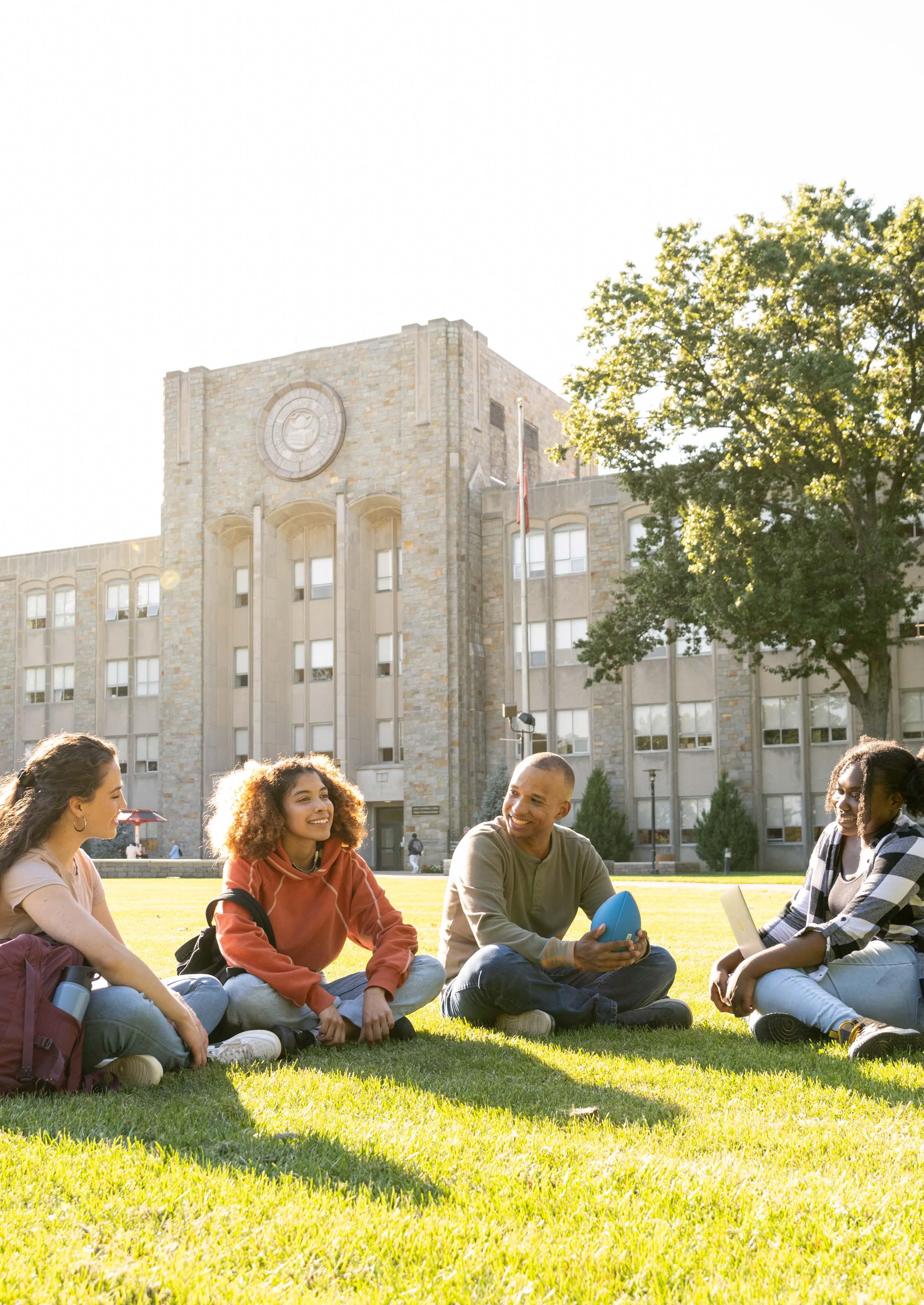






In recent years, the landscape of US student mobility has been shaped by a growing number of pull factors drawing American students to pursue education abroad.
While traditional motivations, such as the pursuit of a global experience, academic excellence, and crosscultural exposure remain strong, new dynamics are influencing this trend. Increasingly, students are attracted by the affordability of international degrees, expanding scholarship opportunities, and the global recognition of institutions in the UK, Europe, Canada, Australia and New Zealand, and beyond.
At the same time, domestic socio-political shifts are adding further impetus for some students to look beyond US borders. The evolving higher education climate and uncertainty linked to potential policy changes under a new administration may be prompting certain students to consider international study as both an academic and personal opportunity for greater openness and stability. Together, these factors are reshaping US outbound mobility, diversifying destinations, redefining motivations, and reinforcing the global nature of higher education pathways.
This report combines real-time social listening with onthe-ground insights from our in-country representatives, who are actively promoting study overseas across key destinations. Their perspectives - drawn from student and parent enquiries, counselor feedback, event engagement, conversion hurdles, and visa/process pain pointscomplement sentiment data to show how concerns about cost, safety, and campus climate translate into actual inquiries and applications. We present practical observations on which messages, programme formats, and support assurances are resonating right now, alongside a comparative analysis of current sentiment. By capturing these responses as they unfold, the report seeks to inform policymakers, education providers, and sector stakeholders of emerging concerns, expectations, and opportunities for targeted support, engagement, and recruitment of US students and engagement. Acumen is proud to partner with Voyage, a powerful education insights platform, for this report, pairing our on-the-ground US experience with real-time listening to international student voices. These findings represent how students are interpreting the current environment rather than a judgment or position by Acumen or Voyage.
By uniting practical know-how and data-driven intelligence, we can better understand what students are saying - and needing. Now more than ever, listening to students isn’t optional; it’s the foundation for smarter strategy, stronger partnerships, and better outcomes.

Kate Barnes Executive Director UK, Europe and North America


Katie Landrey Partner Success Director North America


The US represents a significant and evolving opportunity for international student recruitment. This report draws on insights from Acumen’s US-based experts and Voyage’s social intelligence platform to help institutions navigate and engage this complex market effectively.
Growing interest in international education, coupled with an expanding range of global study options, continues to strengthen the strategic potential of the US outbound student landscape. Interest in full-degree programmes abroad showed promising growth in the 2024-25 cycle, marked by:
> 76% of students said they hoped or planned to study abroad in 2025.(1)
> An 14% increase in US applications to the UK for the 2025 intake.(2)
> American interest in Irish higher education surged 63% in the first quarter of 2025 compared to 2024.(3)
> A 27% increase in graduate applications from the US for programmes starting in the 2025 academic year at University of British Columbia’s Vancouver campus.(4)
This growing appetite reflects a broader shift toward global engagement, especially as students seek personal growth, cultural immersion, and career readiness. There remains a gap between interest and participation, which presents a significant opportunity for international universities to connect with American students who are eager for global experiences.
The US remains a high-potential market for international universities, with over 20 million postsecondary students and more than 400,000 undertaking study abroad annually (short-term mobility and full-degree programmes).(5) Current demand is shaped most strongly by cost, safety and quality of life, and certain socio-political factors that may directly influence intent to apply, destination choice, and conversion.
> Socio-political climate: The recent change in administration has prompted some to explore overseas study options. Increasingly, students are becoming more politically aware, with their individual political leanings shaping how they interpret shifts in domestic policy and leadership. For many, these changes reinforce confidence in staying within the US system; for others, they serve as a catalyst to consider international alternatives that align more closely with their values or worldview. At the same time, students are also weighing the sociopolitical environments of potential destination countries, assessing factors such as stability, inclusivity, and global outlook, before deciding where to study abroad.
> Cost: Affordability is decisive. In 2025, 65% of US students cited easier access to financial-aid information as their top request (a 50% year-on-year rise).(6) Providers that offer transparent total cost, proactive guidance on scholarships/ aid, and shorter degree programmes (e.g., three-year bachelor’s, 2+2 degrees) position themselves as credible choices for cost-conscious families.
> Safety, inclusiveness, and quality of life: Students and parents increasingly prioritise personal safety, wellbeing, inclusiveness, and overall liveability alongside academic considerations. Demonstrating a clear duty of care, providing accessible and culturally responsive student support, and showcasing study cities known for their healthcare, transport, diversity, and community life all strengthen perceptions of trust and attractiveness. Environments that actively promote inclusion and belonging not only enhance student experience but also signal institutional values that resonate with today’s globally minded learners.



The US has long been recognised as an attractive recruitment market due to its relative stability. Major source markets like China can be impacted by diplomatic turmoil, while others, like India, are sensitive to political changes. Increasingly, political conflicts result in significant consequences for student mobility. For example, in 2023, strained relations between India and Canada led the Indian government to issue warnings to students about risks in the Canadian education system.(7) This followed concerns about the exploitation of Indian students, underscoring how political issues affect educational exchange. Similarly, in 2018, Saudi Arabia withdrew students it had been sponsoring at Canadian schools in retaliation for Canada’s criticism of Saudi Arabia’s human rights record.(8)
The US market doesn’t necessarily present the same potential political pitfalls. Although the US may not provide the same volume of applications as larger countries such as China and India, it remains essential for universities to diversify their recruitment strategies in response to the challenges of the current global landscape. During the pandemic, universities worldwide faced a significant loss of international students from China due to the prolonged closure of the mainland’s borders. As a result, institutions were compelled to seek alternative sources of international students to compensate for the decline in Chinese enrolment.
And unlike recruitment from countries like China and India, a global university vying for an American student is usually competing against US counterparts rather than fellow institutions from the same country. Higher education in the US provides an enviable reputation and US universities account for thirtyeight of the top one hundred institutions in the Times Higher Education’s World University Rankings 2025. The high quality of teaching and research among the country’s leading institutions is a major factor in its appeal as a destination for not only internationally mobile students but for domestic students too. As a result, when recruiting in the US, a university will need to present significant reasons why an American student shouldn’t just stay at home to receive a quality education.
“Often global universities are competing with US universities seeking domestic students rather than with other UK or European universities. This represents a significant shift in perspective from recruitment in other countries where competitors are seen often as institutions from the same country.” says Kate Barnes, Acumen’s Executive Director
Despite these obstacles, and even with the potential recruitment benefits, the US has not been approached as strategically by recruiters compared to other source countries. Markets such as the UK, Canada, and Ireland pose no language barrier to US students, and have long held tight diplomatic ties with the US which has contributed to the perception that recruitment is somehow more naturally organic than in countries where language and cultural issues are apparent.
“Given the smaller volume of outbound students from the US, it can sometimes be overlooked in broader global recruitment strategies,” says Kate.
However, with universities in major English-speaking destinations pressed to vary their international student populations beyond cohorts from China and India, the US provides a valuable opportunity for diversification.
Voyage is an education insights platform working with governments, universities, and enterprises to better understand the voices of international students. Through ‘The Social Source’, our AI-powered platform, we capture and analyse conversations across open and closed digital channels - uncovering the drivers behind student decisions and forecasting emerging trends. We work closely with our partners across key source and destination markets, enabling them to navigate complexity with clarity, respond faster to change, and build strategies that resonate with the students they serve.
Social
When Students Talk, We Listen
> Comprehensive Data Sources: Voyage gathers data from a diverse range of platforms, including major social networks like Twitter, Facebook, and Instagram, as well as online forums, blogs, and other relevant sources frequented by international students. This multiplatform approach captures a wide spectrum of opinions and discussions relevant to the international education sector.
> Targeted Data Collection: Voyage focuses on topics specifically relevant to international students, ensuring that the data collected is directly applicable to the needs and interests of this target audience. This targeted approach avoids the potential biases that can arise from focusing solely on trending topics or general keywords.
> Large-Scale Data Collection: Voyage prioritises collecting large volumes of data to minimise the impact of outliers or random fluctuations. This extensive dataset provides a more accurate and reliable representation of the overall sentiment and opinions within the international student community.
> Advanced Data Cleaning: Voyage employs rigorous cleaning and filtering processes to remove irrelevant information, spam, and duplicate content. This ensures that the data used for analysis is of the highest quality and relevance.
> AI-Powered Sentiment Analysis with Human Expertise: Voyage leverages cutting-edge AI technology to analyse sentiment in social media data. This AI model understands full sentences, accurately determines attitudes, and even grasps basic sarcasm and irony. To further refine the analysis, a team of sector experts with deep knowledge of international students and the education sector review and validate the AI-generated sentiment scores. This combination of AI and human expertise guarantees the accuracy and reliability of the sentiment analysis.










In total, there are 3,633 degree-granting postsecondary institutions in the US (2022-23).(9) Levels of enrolment in higher education vary between states. In 2022-23, the US states with the largest numbers of students enrolled in degree-granting institutions were California (2,486,788 students), Texas (1,567,017), New York (1122,959), and Florida (999,233).(10) In total, 2,365 of the US’s postsecondary institutions offer four-year programmes at bachelor or higher degree level and enrol around 70 percent of the total undergraduate population (10.7 million students). The remaining 30 percent of US undergraduates (4.7 million students) are enrolled in around 1,268 institutions offering 2-year associate degrees and certificates.
Many domestic universities are facing economic challenges, as a result of funding cuts, increased competition for domestic students, and recently a decline in international students inbound to the US. As of February, 2025, about two-thirds of all degree-granting public and private nonprofit universities exhibit one of three key indicators of financial stress: consistently losing money, fewer students enrolled than the decade prior, or a decline in state funding or endowment values.(11) Notably, a much smaller proportion are experiencing two factors (6.4%) and only 1.9% of the universities reviewed are experiencing all three factors. While the conversation around universities’ economic futures has been a focal point in 2025, a report published in 2024 announced that around one university or college was closing each week, often with little warning for staff and students, indicating financial strain may be worsening but is not new for US universities.(12) According to the Federal Reserve Bank of Philadelphia’s financial stress test model for American higher education institutions, assuming worst-case scenario predictions of a 15 percent decline in enrollment, as many as 80 colleges and universities in the US could permanently close their doors by the end of the 2025-26 school year.(13)
Others have closed individual programmes or merged with other colleges in order to cut costs. Meanwhile, high tuition is one of the major factors contributing to high drop-out rates among the country’s students and the reason most frequently cited among the college-age population for not attending college or having a bachelor degree.(14)
The “Enrolment Cliff”
Colleges and universities in the US are preparing for a challenging situation: a projected decline in enrolment. The decrease in birth rates following the 2008 global recession is now manifesting, 16-17 years later, as a reduction in the number of high school students. This so-called “enrolment cliff” is expected to result in the peak of high school graduates at between 3.8 and 3.9 million in 2025 and then begin a gradual descent below 3.4 million by 2041, resulting in about 13% fewer graduates.(15) According to some experts the impact will likely vary by region, if not by state.

New Jersey
8.1 passports per 100 residents
Massachusetts
7.7 passports per 100 residents
Hawaii
7.7 passports per 100 residents
New York
7.3 passports per 100 residents
For example, New York’s share of enrolment has already decreased and the northeastern US, with a large share of the country’s higher education institutions, is expected to be hard hit, while some university leaders in the Dakotas and Minnesota believe they will be less impacted.(16) Some states, such as Montana with fewer students and colleges, may even see slight increases. Small, private colleges with high tuition fees and lacking global rankings are the most vulnerable to the decline in high school graduates. These institutions will likely need to reduce programmes, merge with partner institutions, or face closure. While the demographic decline presents challenges to foreign universities as there will be fewer students to recruit, there may be opportunities during this period of significant change in US higher education.
As the world’s largest economy, the third-most populous country and home to a large tertiary-aged population, the US is expected to retain its position as a leading international recruitment market. While the US’s position is expected to remain strong as an inbound market, current modeling provided by NAFSA predicts up to a 40% decrease of international students entering the US in 2025, which would significantly impact student mobility trends on a global scale.(17) However, its rate of economic growth, while being positive, is likely to be slower than leading emerging economies where rates of outbound mobility are rising faster, and its high quality domestic higher education sector reduces the appeal of outbound study.
US outbound student numbers have grown nearly every year since UNESCO records began, totaling nearly 110,000 in 2020, and representing the fifth-largest outbound market in the world. Favourite destinations for US students include the UK, Canada and Mexico, as well as European destinations such as Germany, France, Spain and Italy.
Nearly half of all Americans now hold a passport, with 196.97 million valid US passports recorded in 2024(18) - a number that continues to rise each year. However, this still lags behind other countries such as Canada, where around 70% of citizens hold passports, and Australia, where the figure exceeds 80%. The contrast underscores how geography, travel culture, and accessibility shape patterns of international mobility and global engagement.
As with the rest of the world, numbers of students heading abroad were severely impacted during the pandemic and have fallen from 347,099 in 2018-19.(20)
Destinations of Outbound US Students in 2022 -23(20)
Africa: 9,163
Asia: 26,350
Europe: 180,778
LATAM, Caribbean, & South America: 30,126
Middle East/North Africa: 6,912
Oceania: 8,944
North America: 1,517
Multiple Regions: 16, 889
Americans are less likely to travel internationally than Europeans. 23% of Americans have never left the country.(19)
Higher rates of international travel are linked to age, education, wealth and urban or suburban living.
The Institute for International Education (IIE) records 280,716 US students enrolled abroad for academic credit in 2022-23. Its latest Open Doors Report records 64.4 percent of these as heading to Europe.


Academic Year Breakdown of Outbound US Students in 2022-23(20)
Figure 4: Academic Year Breakdown of
Freshman Year
Sophomore Year
Junior Year
Senior Year
Bachelors (Unspecified)
Master’s Students
Doctoral Students
Graduate Professional Students
Graduate (Unspecified)
Gender Breakdown in 2022-23(20)
Figure 5: Gender Breakdown in 2022-23
Fields of Study in 2022-23(20)
Figure 6: Field of Study in 2022-23

US students have always shown an enthusiasm for studying abroad, driven by a mix of academic, personal, and socio-political factors. Many have sought renewed global engagement after the pandemic, motivated by curiosity, adventure and cross-cultural learning, while rising domestic costs and competitive job markets made international degrees appear more valuable and affordable. Expanded university partnerships, accessible funding options, and the influence of peers and social media further normalised study abroad as a mainstream academic pathway.
In previous years, the expansion and diversification of study-abroad programmes was considered complementary to US foreign policy goals, as well as issues such as climate, democracy and human rights, economic development, and entrepreneurship.
The US Department of State awarded nearly $1.3 million to a selection of US colleges and universities to create and expand study abroad programmes through the Bureau of Educational and Cultural Affairs’ Increase and Diversify Education Abroad for US Students (IDEAS) programme in 2024.(21)
Other initiatives to boost outbound mobility and international relations include the partnership between NAFSA, the US State Department, and Partners of the Americas to create a public-private partnership for the 100,000 Strong in the Americas Innovation Fund to increase educational exchanges in the Western Hemisphere and strengthen US relations with the countries of the Americas.(22) Another is the IIE’s ongoing Generation Study Abroad initiative, originally launched in 2014 with an initial investment of $2 million, to expand the number and reach of study abroad scholarships for outbound US students, supported by institutional partnerships.(23)
As well as fostering intercultural understanding and a global perspective, study abroad has been shown to have numerous academic benefits. According to research from the CASSIE initiative, study abroad experiences improve retention, completion rates, and even GPAs.(24) Additionally, these programmes enhance employability by providing students with internationally valued skills like cross-cultural communication and global awareness, which are increasingly important in today’s interconnected workforce. Many students also benefit from post-study work visas, allowing them to gain practical experience abroad before returning home
Interest in going abroad has recently increased: a 2025 survey of US college students found 76% hoped or planned to study abroad (up from 73% the year prior).(25)
Early signals in 2025 suggest a measurable uptick in US students exploring degree and study-abroad options overseas. Motivations vary - programme length and cost clarity, work-rights, quality of life and perceived policy stability, but several destination-country data points illustrate the shift.
An education abroad experience is imperative on the individual and societal level. Study abroad must be made available to students of diverse backgrounds and therefore democratised. Students who study abroad develop critical thinking, problem solving and intercultural competence skills that are vitally important. The US needs future policy makers, business people, scientists, and social entrepreneurs with global perspectives or it will be left behind.”
Being on the FAFSA list of universities is crucial, as it allows students to apply for financial aid through FAFSA. Durham’s presence on this list can significantly influence students’ decision to attend, making financial support more accessible.”
Alyce Myers International Officer
Durham University
> UCAS reports a record number of US applicants for 2025 entry (6,680 by the January deadline, +12% YoY; 7,930 by 30 June, +13.9% YoY).(26)
> Home Office visa data show 14,472 sponsored study visas were granted to US nationals in the year ending March 2024 (stable YoY).(27)
> The Home Office also notes an 18% rise in total study visas in the first half of 2025 vs the same period in 2024.
> The Department of Home Affairs shows Higher Education sector student visas granted to US citizens outside Australia rose from 2,418 to 3,324 to 31 Dec 2024 (+37.5% YoY), despite English and financial thresholds being tightened in 2024.(28)
> Immigration NZ data (via Figure.NZ) show 2,880 student visas granted to US citizens in 2024, up from 2,592 in 2023 (+11% YoY).(29)
> Residence permits for study: Eurostat shows education as the leading reason for first residence permits in Ireland (near half of all first permits in 2024). While most US students do not require an entry visa, they do obtain residence permission for stays over 90 days - making permit trends a useful proxy for inbound study.
US federal student loans may be applicable to study abroad, but students should check which international universities participate in the US’s various loan programmes, including the Direct Loan programme and the Federal Student Loan programme as early as possible. Around seventy-five non-US universities are recognised by the US Department for Education for the Free Application for Federal Student Aid (FAFSA) programme, or the Federal Student Aid process. To be eligible for inclusion in the FAFSA programme, a foreign institution must have the appropriate legal authorisation and degree recognition from the country in which it is located; proof of public or non-profit status; financial responsibility and administrative capability to administer the Direct Loan programme; and appropriate accreditation, and additional requirements if it is a medical, veterinary, or nursing school.
In the US, college fees vary significantly and are a key consideration for applicants. Most students rely on Federal Loans and leave college with high levels of debt. According to US News & World Report, average undergraduate tuition in 2025-26 at a public university for an in-state student was $11,371, versus an average of $25,415 for an out-of-state student.(30) In comparison, average tuition for all students enrolled at a private university was $44,961. Nationwide, public on-campus room and board costs account for an additional $13,847 per year on average.(31)
*Tuition and fees plus room and board
The need to diversify recruitment pipelines and open new channels of engagement has never been greater. Community college recruitment is key. Every year, over 10 million students study at more than 1,000 community colleges across the United States. Nearly half of them go on to complete a bachelor’s degree by transferring to a four-year institution. These students are intentional, motivated, and ready to succeed, yet international universities have had few structured pathways to reach them.”
Emma Schwartz Transfer Abroad Network
Recruiting US students who are aiming at public universities as in-state applicants can be a challenge as those institutions offer financial benefits. However, when weighing out-of-state tuition fees charged by public universities as well as regular tuition charged by private universities, foreign universities can demonstrate value, especially if only three years’ of required study. Many attend community college for financial flexibility, but this includes students from affluent areas as well as middle-income families. In California’s wealthiest districts, up to 35–50% of graduates start at community college. These students are price-sensitive, not resource-poor, and many have funds set aside for their final degree years.
The availability of scholarships for American students at foreign universities are scarce and most are available directly through universities. Most are awarded on merit, many are subject-specific, and some are to assist equal access. US students occasionally acquire scholarships to study overseas from commercial and charitable organisations at home. While the high cost of private universities in the US - with tuition, accommodation and fees at Ivy League universities closing in at $90,000 a year - are often cited, there are a wide variety of scholarships for students pursuing other higher education pathways, often at the state level. For example, the HOPE scholarship in Georgia helps fund the postsecondary education of in-state students demonstrating academic excellence. In New York, there are state scholarship schemes across a wide variety of fronts, supporting academically strong students as well as those that are undocumented.(33) There are scholarship schemes at public university systems, such as the State University of New York and the University of California. Universities, too, have their own scholarships, often based on merit, financial need or a push for diversity. The University of Illinois UrbanaChampaign has two scholarships for Native Americans, one for students connected to the state of Illinois and one for those out-of-state.
Safety is top-of-mind for students and parents. Recent national surveys from Terra Dotta show strong interest in study abroad alongside rising safety and geopolitical concerns; in 2025, 76% of students said wars and global conflicts affect their interest in going abroad, and in 2024 “general safety” and “parental worries” were among the most prominent deterrents, pushing universities to demonstrate robust duty-of-care in programme design.(34) Domestic anxieties compound this: a 2024–25 American College Health Association brief reports that 65% of college students say school shootings influence their sense of safety on campus, keeping personal security front-and-centre as they weigh where to study (35)
Quality-of-life can be a draw to study overseas. Cities popular with US students - such as Melbourne, Sydney, Vancouver, and Auckland - consistently land in the Economist Intelligence Unit’s Global Liveability Index top 10 for stability, healthcare, education, and infrastructure, while QS’s Best Student Cities 2025 places Melbourne, Sydney, and Montreal among the global leaders (36) At the same time, contrasts in policy climate are sharpening choices: multiple US states have enacted laws restricting DEI activities at public universities (e.g. in Texas and Florida), prompting office closures and programme rollbacks.(37) Together, these factors, heightened safety concerns, attractive liveability abroad, and clearer inclusion frameworks in many destination countries are driving more US students to explore study options overseas.
American students often find the UK’s three-year focus on their major appealing, bypassing general education requirements. For those wanting a broader experience, studying abroad or pursuing a Master’s might be better. Many students are eager to explore and experience new opportunities, driving their interest in studying in the UK.”
Karmen Mallow Regional Manager, Imperial College London

This section uses post, comment, and engagement data from a wide range of online sources, including social media, forums, news sites, etc., sourced and segmented using keyword-based strings.
As seen in other global markets, changes in administration often create a point of comparison for student sentiment, particularly when shifts in policy may directly affect higher education.
Over the past year, perceived domestic policy changes have emerged as notable factors influencing outbound study decisions. Online discussions among US students about studying abroad intensified during the 2024 presidential election cycle and the 2025 inauguration period, reflecting heightened concern around policy direction, affordability, and sense of belonging. For some, this period has prompted renewed interest in the advantages of an overseas education and the personal and academic opportunities it can offer.
Two critical periods define this analysis:
> Sep–Dec 2024: Campaigning and election build-up shaped conversations around tuition affordability, admissions fairness, and long-term prospects for higher education within the US.
> Jan–Sep 2025: Concern about potential policy shifts under the incoming administration.
Key topics of debate included the election season surge in outbound chatter, the Harvard admissions controversy that reignited discussions around fairness, high-profile student deportation cases linked to protests, and federal funding freezes that introduced uncertainty for academic programmes. Collectively, these developments reshaped perceptions of outbound mobility — positioning study abroad not only as an appealing opportunity but, for some students, as a practical alternative in response to domestic uncertainty.
Comparative Analysis: Volume-Over Time & Peak Moments of Online Discussion (Pre- vs Post-Election)
10: Volume-Over Time and Peak Moments of Online Discussion (Pre- vs Post-Election)
The idea of finishing a degree in three years instead of four really appeals to me. I like that in the UK you can dive straight into your major without all the general education classes — it feels more focused and efficient, and I’d be saving a year of tuition and time.”
I’m looking at master’s programs in the Netherlands because they’re shorter, more specialised, and still taught in English. It feels like you actually get to study what you care about from day one, rather than spending years ticking boxes like in the US system.”

Conversation volume related to Outbound US saw a drastic, sustained increase following the recent change in administration. Average weekly mention volumes increased by 98.9%, primarily driven by five conversation peaks in the immediate aftermath and in the months after.
Conversation Peaks
Peaks were driven by perceived signals of changes in academic life in the US. These signals include departure of prominent academics and media coverage of new government policies.
(A) Week of 4 Nov 2024 - The 2024 Presidential Election
The change in administration sparked some conversations about studying outside the US and education as a springboard for eventual immigration. Many users expressed concern about potential policy shifts under the incoming administration. Some users cited them as an impetus for pursuing foreign education. Financial concerns were also cited, with some users commenting that foreign education could be cheaper
(B) Week of 10 Feb 2025 - A Way Out
Many mentions within this peak revolved around students exploring opportunities to study or word abroad, often framed as seeking greater personal or academic stability. Some discussions also questioned how conducive the domestic higher education environment was becoming for long-term study and research.
(C) Week of 24 Mar 2025 - Brain Drain & Academic Freedom
Headlines of Yale Professors moving to Canada, with one notably specialising in the study of fascism fuel fears of a brain drain from US academia. The departure is perceived as a red flag for the future of academic freedom in the country.
(D) Week of 19 May 2025 - Brain Drain & Academic Freedom (Part 2)
A Facebook post discussing US students leaving the country was made by The New York Times, garnering high engagement. The conversation about US brain drain continues within online mentions alongside a continuation of discussion about the departure of professors from Yale
(E) Week of 4 Aug 2025 - Changes in internatonal student policies
Several news agencies report on the administration’s move to reduce incoming international enrolment to US universities and the forecasted economic impact Posts received mixed responses from the public within comment sections. Some sentiment around the future of academia in the US is somewhat negative.
Mentions
The volume of online news saw a marked increase (+38.9%) between preelection and post-election periods, although this increase was not nearly as pronounced as the spike in volume (+98.9%) within student voice mentions. This is a result of an increase in newsworthy stories relevant to academics and academia, often due to certain actions by the new administration.
Online news stories in the pre-election period revolved around international sporting events and research collaborations between universities, alongside the occasional anecdotal article about how college education abroad impacts family life
The post-election period saw a shift in online news mentions about outbound US mobility for education. Conversation peaks were related to legal battles surrounding international student deportations, and concerns about brain drain due to the departure of established academics and students alike.
Analysis: Sentiment in Online News Coverage (Pre & Post Election)

Sentiment of post-election coverage is characterised by an increase in negative sentiment (+22.8 pts) within online news.
Prior to the election, articles coded with a negative sentiment were limited in volume, with most covering anecdotal student experiences such as missing the “American school spirit”, commentary on American student debt, or feeling conflicted about moving back to the US after a college education abroad.

The change in administration was a pivotal moment for Outbound-US related online news. Mentions primarily revolved around the impact of the new administration’s policies on college students, educators, and the future of academia as a whole. Notable themes within negative sentiment-coded articles discuss the prospect of US losing scientific talent to the rest of the world, crackdowns on international students, and cuts to scientific funding.
Emotional Volume in Online News Coverage (Pre & Post Election)


The emotional tone of online news shifted noticeably between the pre- and post-election periods. Before the election, emotional sentiment was relatively balanced, with articles reflecting anger (34%), fear (23.9%), sadness (23.3%), and joy (18.2%). After the election, sadness became the most prevalent emotion (51.8%), while anger declined significantly as an underlying tone.
Prior to the election, coverage tended to be more varied in focus. Stories highlighting academic achievements often conveyed “joy,” while human-interest features about students and families adapting to relocation were more likely to register as “sadness.” Some pre-election articles categorised under “fear” reflected concerns about procedural issues such as absentee voting for students studying overseas.
Following the election, “sadness” and “fear” became the emotional drivers in outbound US-related news. Many articles expressed concern about potential declines in research competitiveness, the outward mobility of academic talent, and evolving border and visa policies affecting international student movement.
PT886 in combination with Merck
collaboration agreement with Merck broadcast outside the United
4 June 2024 to 6 November 2024
The most prominent phrases featured within pre-election news revolved around sporting events and academic collaboration.
7 November 2024 to 4 September 2025
Following the election, political leadership (“White House,” “Senate,” etc.) became a prominent focus in news coverage related to international education. Phrases such as “academic freedom,” “scientists may choose to leave,” and “brain drain” highlighted concerns about potential challenges and changes in the academic environment.




Key Insights from online conversations
Mentions
The volume of student voice mentions nearly doubled in volume (+98.9%); this is a result of an increase in responses to policy changes by the new administration within the space of academia.
Pre-Election Period
Social mentions prior to the election revolved around advice-seeking behaviour, including budgeting advice, transferability of educational attainments, and cultural questions regarding aspirational study destinations.
Post-Election Period
Social mentions following the election have become noticeably more emotive, reflecting responses to recent policy developments and broader shifts in the national climate. Common themes include interest in pursuing education abroad, discussions around early departures for international study, and reflections on how changing domestic conditions may influence student mobility and talent flows.
Comparative Analysis: Sentiment in Online Social Coverage (Pre & Post Election)
Sentiment of post-election conversation is characterised by increased negativity (+5.9 pts) and slightly less positivity (-0.8 pts).
Pre-election negative mentions generally fell into three broad themes: financial constraints preventing the pursuit of college education abroad, comparing the value of degrees from within and outside the US, and navigating rules surrounding international study.
Post-election negative mentions became more thematically focused, centring on concerns about the future of academic freedom, the re-evaluation of opportunities for education and research, and the potential for talent migration from the US. These themes were reflected in the largest spike in discussion volume, which coincided with the departure of three Yale professors — including one whose research explored political systems and governance. Increased negativity can be attributed to the newsworthiness and current event-driven nature of the topics post-election.
Both pre-election and post-election conversations feature sadness (37.8% vs. 37.2%) as the dominant emotion. However, the overall volume of emotional mentions was noticeably higher post-election. Conversely, some students expressed optimism about renewed domestic investment in research and innovation, viewing the changing landscape as a catalyst for reform and new opportunities within US higher education.
The nature of topics contributing to this “sadness” differed between periods. Before the election, sadness often reflected missing the US while studying abroad, financial concerns, or uncertainty about future career prospects. After the election, sadness was more often associated with perceptions of challenges within the US academic and research environment, potential talent migration, and the broader implications for higher education.
Mentions characterised as “fear” in both periods frequently related to financial anxiety. Post-election discussions also included concerns about navigating changes in the domestic context, making decisions about studying or working abroad, and uncertainty about future opportunities in the US.

4 June 2024 – 6 November 2024
Congress Amazon Dominate Comissioning NRA
Kamala Trump
Organisations People Phrases
international student PhD programs work experience green card
bachelor’s degre
college football law school leaving America recent study law degree
students studying puppet masters REAL world
7 November 2024 – 4 September 2024
American lead in funding research college options increase in the United Emirati student body is increasingly longer for research uproot brain drain
National Institute of Health
National Science Foundation
NASSA Apple Associated Press White House
Levin Emirati Daniel Palm
Lisa Johnson Kanis Leung
institutions’ satellite campuses universities set up campuses
Illinois Tech
education global education
Trump administration
Johnson
Harvard Harvard University American Academy for Girls
foreign students student visas
Department of Homeland Security Senate
Daniel Bill
Alx Marselle Alx Marselle University
leave the United States students wants and dreams
principal of Dubai Britain stands to gain scientists will choose to leave hosts dozens of international institutions private American Academy for Girls interested by money months for universities to review applications academic freedom to be preserved
Organisations People Phrases
The two word clouds provide a snapshot of thematic emphasis in online social discourse across distinct phases from June 2024 into 2025.
4 June 2024 to 6 November 2024
Common phrases within the pre-election period reflect the generic nature of US outbound-related conversation, such as high school-to-college paths, foreign campuses, and university programmes.
7 November 2024 to 4 September 2025
The phrases emerging in the post-election word cloud highlight topics increasingly recognised as push factors and challenges for US academia, including “brain drain” and other concerns related to the evolving academic and research environment.
Key insights from online conversations
Pre-Election: Key Themes Avg. Unique Weekly Mentions
Post-Election: Key Themes Avg. Unique Weekly Mentions
“Cost” was the top-mentioned consideration within US outbound conversation prior to the results of the change in administration. After the change mentions associated with all three factors increased across the board, with “Safety & Quality of Life” mention volumes increasing by an average of 68.1%, “Cost” by 60.8%, and “Political Climate” increasing by 287.1%. The largest shift observed in “Political Climate” caused it to overtake “Cost” as the dominant factor within outbound US conversation.
For some students, the decision to study abroad is shaped by a combination of academic, social, and environmental considerations. Concerns about domestic conditions — including uncertainty in institutions, limited opportunities in specific fields, or social factors — influence destination choice. Many students focus on countries such as Canada, Germany, or broader Europe, which are perceived as offering stable, supportive, and inclusive academic environments. Field-specific considerations, such as career pathways in areas like library science or education, also play a role in shaping mobility decisions.
Alongside these practical considerations, factors such as personal safety, access to affordable healthcare, and inclusive campus communities increasingly influence students’ plans. Environments that promote wellbeing and a sense of belonging can make international study more attractive and reassure both students and their families.
Not all students view domestic conditions negatively. Some interpret recent developments as positive signals for progress, opportunity, and investment in research, which may reinforce confidence in pursuing USbased study or influence destination choices in like-minded countries. Even so, broader social, institutional, and wellbeing factors remain meaningful: while some high-school students plan to study abroad immediately after graduation, prospective PhD candidates and other long-term students carefully weigh the academic environment, community inclusiveness, and support structures of potential destinations before committing.
I would want to start somewhere that mainly speaks English just because I’ve never been abroad before and I want to ease into it, but I do eventually want to immerse myself somewhere like Germany so I can learn the language and about the culture better than I could otherwise.”
As an American considering studying abroad, I’m really drawn to Bond’s program. The thought of experiencing a new culture, making friends from all over the world, and enjoying that Aussie sunshine is pretty tempting.”
Healthcare, transit, cost of living — it all adds up. I’m looking at grad school in Germany partly because I can live decently on a student budget without taking on insane debt. Quality of life matters more to me now than chasing prestige.”
Rising tuition costs continue to be consistent drivers of outbound mobility among US students. Parents actively encourage their children to consider Germany or Spain, where affordability is paired with high-quality programmes. Countries such as Norway and Finland are also cited as destinations that not only minimise costs but, in some cases, provide stipends to students. For many, studying abroad can be less about cultural exploration and more by the opportunity to access high-quality education at a lower cost.
The idea of finishing a degree in three years instead of four really appeals to me. I like that in the UK you can dive straight into your major without all the general education classes — it feels more focused and efficient, and I’d be saving a year of tuition and time.”
Safety continues to be a key consideration for students, with concerns including personal security and broader campus safety. Structural factors such as high housing costs, limited public transit, and the affordability of healthcare can heighten these worries. For some students, particularly those from marginalised groups, the US is perceived as challenging both financially and socially.
By contrast, studying abroad is often seen as an opportunity for greater stability, offering access to more affordable healthcare, secure communities, and the chance to experience life and education in a new environment.
“After visiting Melbourne, I was amazed at how clean the city felt and how easy it was to get around. Public transport just works, and people actually seem relaxed. I couldn’t believe how different the pace of life was compared to the constant stress back home.”
“One of the biggest reasons I’m looking at studying abroad is safety. It’s not just about crime or gun violence — it’s about feeling secure day to day. When I visited Canada and the UK, I noticed how relaxed it seemed on campus, and that sense of calm really stuck with me.”
“Canada feels like a safer long-term bet in terms of funding stability and basic social infrastructure, even if the job market is still tough. I am hoping this move can set me up for broader options, whether that ends up being academia, policy, government work, or something interdisciplinary.”

The future of recruiting US students to study overseas continues to hold significant potential, driven by the appeal of shorter degree programmes, particular subject areas, lower tuition fees, and the rich cultural experiences that these countries provide.
The sector worldwide is currently contending with considerable headwinds. While administration change doesn’t normally impact US student mobility the way it might in other source countries, it’s difficult to predict the outcome of some policy changes. In addition, the UK, Canada and Australia are experiencing policy shifts towards limiting inbound students, after hitting record-high numbers of international enrolment. Public sentiment towards international students often lumps them in a larger discussion regarding immigration, so distinguishing the value of international students - from any country - and emphasising the cultural and financial contributions they make should remain a priority for all universities.
Universities in the UK, Canada, Europe, Australia, and New Zealand have much to gain by increasing their strategic focus on the US. By highlighting the benefits of studying abroad, such as gaining global perspectives and enhancing cultural awareness, these countries can position themselves as attractive destinations for American students seeking to broaden their horizons. Continued investment in marketing efforts, partnerships with US institutions, and on-the-ground engagement with American students will be crucial to success. As the world becomes increasingly interconnected, the value of international education experiences will only grow. That trend will undoubtedly underscore efforts to explore the potential of the US as a reliable and sustainable recruitment market.

Our shared history and values keep the UK-US relationship strong. Despite recent challenges, our economic and educational ties continue to thrive.”
A representative from the Department for Business and Trade (DBT)
Most Europe co-mentions did not reference specific countries (e.g. mentioning “The EU” or “Europe” only). Among mentions that did specify a country/city, Germany led in mention volume by a large margin, followed by France and Ireland.
The UK has potential to build upon its existing appeal to American students, leveraging its long-standing economic and diplomatic ties with the US. PostBrexit, UK universities have seen a 50 percent rise in US students, with Americans drawn to lower costs through shorter programmes and the opportunity to study at branded universities. The prestige of a UK education is also a compelling factor.(38) In 2025, twelve UK universities were ranked in the top 100 of the Times Higher Education World University Rankings, with three of these in the top ten, including the University of Oxford, which was ranked first. Cultural familiarity, a shared language, and historical connections provide a solid foundation for increased engagement with ambitious American students.
The relationship between the UK and the US is underpinned by shared cultural and historic ties, including language and legal principles. The UK is one of the US’s top trading partners, the economic ties have remained strong. During President Trump’s September 2025 state visit to the UK, he announced over $10 billion in new economic deals, including partnerships in technology, energy, and defense innovation.(39) Trade relations remain strong — the US is the UK’s largest single trading partner, accounting for 18% of UK trade and around £1.2 trillion of bilateral investment.(40) With Americans drawn to lower costs through shorter programmes and the opportunity to study at branded universities the interest from US students to study in the UK hit a record high last year, up 14%, and the Home Office data showing last year the highest number of sponsored study visas since 2009.(41)
UK universities have a significant opportunity to attract more US students by leveraging shared cultural ties, competitive tuition fees, and high-quality educational offerings. Despite challenges like Brexit, there has been a notable rise in US student enrolment, driven by factors such as shorter degree programmes and the prestige of UK institutions. To further enhance their appeal, UK universities should broaden their admissions criteria to include Advanced Placement (AP) qualifications and SAT/ACT scores, aligning more closely with the holistic admissions approach of US institutions. Expanding participation in platforms like the Common App could also streamline the application process, increasing access for US students. Additionally, universities should focus on clear communication about grading differences and provide tailored support to help US students transition to the UK’s academic system. By emphasising their cost-effectiveness compared to US institutions, particularly when considering the shorter programme duration, UK universities can position themselves as attractive alternatives for American students seeking a global education experience.
For many American students, the UK stands out because of lived experience as much as reputation. Alumni of semester programs often describe their time there as exciting, rewarding, and academically stretching, experiences that translate into applications for postgraduate studies later on. The appeal is practical as well as cultural: a clear degree structure (typically three-year bachelor’s in many subjects), research-active universities in dynamic student cities, straightforward credit recognition, and English-language instruction that lowers barriers to entry. Coupled with rich arts and heritage and easy access to the rest of Europe for travel and placements, the UK feels less like a leap into the unknown and more like a confident, well-supported next step.
In a period of change for US higher education and research, students and researchers are increasingly looking outward for new academic and professional opportunities. Europe is widely viewed as offering academic freedom, consistent research opportunities, and stable democratic norms. Cost is a powerful pull, too: compared with the US, Europe offers more affordable pathways through tuition-free or lower-fee programmes, manageable living costs, and, for some, advantages tied to dual EU citizenship. For many American families confronting escalating tuition at home, Europe’s combination of value and stability is an appealing alternative.
Ireland and a range of wider European destinations are capitalising on this interest. Ireland’s English-language instruction, cultural affinity with the US, and sustained investment in higher education and innovation reduce barriers to entry. Across Europe, countries such as the Netherlands, Germany, France, Spain, and Italy offer high-quality programmes, often at lower tuition levels, with English-taught options expanding rapidly. Universities are also meeting students where they are: the Association of International Regional Representatives – North America (AIRR-NA) now counts 93 members representing 50 institutions(42), with US-based teams engaging students, families, and counselors throughout the application journey. Add in Europe’s cultural diversity, vibrant cities, and easy cross-border travel, and the result for American students is a compelling blend of prestige, affordability, and a gateway to global networks.
UK universities offer American students a specialised, practical, and focused academic experience. It prioritises in-depth study over breadth, which is why the typical three-year degree structure allows students to immediately delve deeply into their course subject without general education requirements. This structure results in both significant cost savings and quicker entry into the workforce. Additionally, the Graduate Route visa allows graduates to remain in the UK after graduation to gain the global experience necessary to compete and succeed in today’s job market.’’
Grace Musante
Student Recruitment Officer
London School of Economics and Political Science
Ireland is not only a friendly and safe country but also a diverse, close-knit community where US students can feel at home during their studies and beyond. With opportunities to remain in country after graduation, many students have earned successful careers with top technology, medical, and leading global companies.’’
Michaela Luedke
Regional Advisor, North America Maynooth University
The expanding presence of international universities in the United States reflects a powerful commitment to global collaboration in higher education. AIRR-NA, the Association of International Regional Representatives – North America is a professional community dedicated to supporting international university admissions professionals who operate in the North American market. Its members represent universities from around the world and work to connect students, families, and counselors with global higher education opportunities. With 93 unique members from 50 institutions across 13 countries, AIRRNA is proud to be at the forefront of this movement, fostering academic exchange, innovation, and crosscultural understanding that enriches both our campuses and our communities.”
Amanda Lunberg
Membership Chair of AIRR-NA and Regional Manager, Americas University of Roehampton
While physical distance is a challenge when marketing degree programmes in Australia and New Zealand to US students, there is evidence that interest can be expanded.
Australia is the seventh most-popular study abroad destination for US students, with 5,449 Americans studying in Australia (43). Students are drawn to the natural beauty of Australia, and the possibility of living close to beaches and mountains, especially young people living in urban areas. In 2024, six Australian universities were ranked in the top 100 of the Times Higher Education World University Rankings, which will further enhance the country’s reputation for quality education. In addition, the US is Australia’s top research collaborator, with more than 39,000 co-authored scholarly publications between 2010-2014.(43)
Australia, especially Melbourne, is widely perceived as open and welcoming for those seeking safety, community, and quality of life. Students describe the culture as progressive and more politically moderate than the United States, with everyday respect for diversity. Accessible healthcare, strong neighborhood networks, and a vibrant arts and food scene reinforce the appeal of studying and living there.
It is also seen as a practical choice for education-to-career pathways. Study options align with clear work opportunities, from the Working Holiday Maker programme to skilled migration routes. In-demand fields such as nursing and pharmacy are frequently cited as fast tracks, while postgraduate study is viewed as both accessible and a potential bridge to longer-term residency. Together, these pathways position Australia as a place where US students can build careers as well as long-term stability.
New Zealand attracts US students seeking degrees that are recognised internationally and taught in a relaxed and welcoming environment. The country’s education system is highly regarded, with all eight of its universities ranked among the top 3% globally. Students in New Zealand are encouraged to think critically, collaborate, and innovate, supported by a system that emphasises quality at every level, both in public and private institutions. New Zealand is often described as safe, beautiful, and culturally open - an appealing “fresh start” for students leaving the US - friendly communities, stunning natural scenery, and an inclusive ethos that many feel offsets a relatively high cost of living. Beyond lifestyle, it offers practical education-to-work routes: well-regarded PhD and master’s programmes, post-study work options, and an accessible Working Holiday Visa for younger applicants. Together, these features make New Zealand attractive to students who want high quality of life while pairing their studies with clear pathways to gain experience and, potentially, longer-term residency.
Canada attracts US students looking for educational opportunities that are close to home while offering safety and cultural diversity. Ranked third out of 85 countries for quality of life, Canada combines a high standard of living with a strong academic reputation.(44) In 2025, three Canadian universities were listed in the Times Higher Education Global Top 100, highlighting the country’s excellent higher education options. Further, Canada provides most international students the opportunity to work, typically up to 24 hours a week while pursuing a degree, enabling students to gain experience alongside their academic coursework.(45)
These destinations have each held entrenched appeal to international students from major source markets like China and India. Applying a similar strategic focus to the US could significantly boost the enrolment of American students in full-degree programmes in these countries. By highlighting the cultural connections, academic prestige, and global opportunities that these destinations offer, institutions can attract American students looking to expand their educational experiences internationally.
Canada is increasingly viewed as a smart alternative to both the US and Europe, offering strong universities, lower tuition, and more affordable living costs. Institutions like Waterloo and McGill are specifically named as attractive for their academic reputation, proximity to the US, and reasonable expenses. For many students, Canada strikes the right balance between quality, cost, and accessibility, making it a top choice for those looking to avoid the financial and social challenges of studying in the US or Europe.
New Zealand’s eight universities offer specialised, affordable postgraduate programmes, with shorter durations and domestic fees for PhDs. The Green List prioritises visas for graduates in high-demand fields like teaching, providing a potential pathway for those wanting to stay long-term. This makes New Zealand a compelling option for US students.”
Ashley Monaghan Regional Manager
The University of Auckland
Many Canadian universities also offer a variety of active learning opportunities, like co-ops, embedded into many universities’ academic programmes. This is a great opportunity for students to have an immersive experience, a sneak-peak into what their future may look like, and build a strong network before they’re ready to graduate. For example, at the University of British Columbia, 90% of co-op students receive a job offer within one month of graduation.’’
Tomoka Mano
Associate International Student Recruiter/Advisor, Global Recruitment University of British Columbia
Key Findings
> Outbound Interest Surge
Comparing pre- and post-election data, mentions of studying abroad roughly doubled. Peaks in conversation about US student mobility corresponded with periods of heightened national attention, with each peak exceeding the last.
> Push and Pull Factors
Cost, safety and quality of life, and broader domestic conditions were the primary drivers influencing outbound mobility. Common sub-themes included concerns about financial pressures, perceived limitations in academic or career opportunities, and uncertainties around institutional environments.
> Dominant Sentiment
Across sources and platforms, online discussions about US student mobility tended to be negative, with sadness and fear emerging as the primary emotional drivers. News content showed the largest shifts in tone between the two periods.
> Destination Preferences
Most conversations were not destination-specific, reflecting a general desire to pursue study opportunities outside the US. Among mentions that did specify preferred destinations, Europe (33%), Canada (28.8%), the UK (25%), Australia (9.6%), and New Zealand (3.5%) were most frequently cited.
> Pull Factors
Students’ interest in particular destinations largely reflects three themes:
• Accessibility: Distance, cost, and cultural fit.
• Security: Personal safety, supportive environments, and healthcare.
• Predictability: Clear pathways for work, visas, and future academic or career prospects.
> Narrative Shifts
Pre-election discussions tended to frame study abroad as a proactive, opportunity-driven choice. Post-election conversations increasingly highlighted study abroad as a response to uncertainty in domestic conditions, with students seeking stability and access to supportive academic environments.
The findings suggest that outbound mobility among US students is still shaped by traditional “pull” marketing from destination countries and, increasingly, by factors within the US that influence students’ decisions. Institutions recruiting US students should consider the following strategies:
1. Address domestic considerations directly
> Recognise factors such as affordability, campus climate, and broader social or institutional conditions in outreach messaging, without framing them politically.
2. Highlight stability and support
> Emphasise predictable visa policies, funding pathways, accessible student services, and inclusive campus culture to build confidence and trust.
3. Align timing and campaigns
> Capitalise on periods of heightened attention — such as major academic milestones or policy updates — when interest in studying abroad typically surges.
4. Leverage mixed data sources
> Combine social listening trends, qualitative feedback, and recruiter intelligence to identify and validate emerging shifts in student motivations quickly.
5. Recognise audience-specific motivations
> Perceptions of key factors vary widely across student groups. For example, considerations around stability or opportunity may carry different weight for a minority undergraduate than for a postgraduate PhD candidate. Likewise, “safety” and wellbeing may be interpreted differently by students in different fields of study.
> Changes in the domestic environment will not influence all students equally — while some may view certain developments as encouraging or restrictive, others may remain largely unaffected depending on their background, field of study, or funding pathway.
1. Segment and Prioritise the Market
> Identify high-performing cities and states by analysing past enrolment patterns, emerging outbound student volumes, and demographic indicators of study-abroad intent.
> Highlight “opportunity states” where outbound potential is growing and competition remains limited.
> Focus outreach on high-engagement regions — those with strong IB/AP participation, international curriculum presence, and established study-abroad cultures.
2. Build Early and Targeted Engagement
> Begin outreach early with counsellor briefings, webinars, and in-person school events to establish familiarity and trust.
> Keep communications personalised and practical, providing:
• Detailed cost breakdowns and funding checklists.
• Programme outcomes, visa/work pathways, and graduate success stories.
• Explicit commitments to student support, accessibility, and inclusion.
3. Review and Refine Admissions Criteria
> Benchmark entry standards and accepted student profiles against domestic and international competitors.
> Conduct a US-specific admissions audit to ensure transparency and clarity:
• Map common US qualifications (AP, IB, honours tracks, dual-enrolment, community-college transfers).
• Clarify GPA scales, test-optional policies, and credit/ advanced standing rules (e.g., AP/IB credit).
• Publish clear entry grids and align recruitment activities with US school calendars.
• Expand English-language waivers where appropriate and simplify document/visa guidance. Making admissions requirements predictable and easily understood will reduce friction for students and counsellors, improving conversion outcomes.
4. Prioritise Personalised Support
> Dedicate staff and systems to timely, individualised follow-up to match the high-touch service standards of US domestic institutions.
> Use CRM and automation tools strategically to maintain responsiveness while preserving a personal touch.
5. Communicate Costs Transparently
> Present clear, comparable details on programme length, tuition fees, accommodation options, and living expenses.
> Offer cost calculators or downloadable budget guides to help families plan confidently.
6. Build and Leverage Partnerships
> Review existing relationships with US colleges and universities to identify potential recruitment pathways.
> Explore new collaborations, such as credit recognition agreements with community colleges or 2+2 transfer routes, to enhance accessibility and visibility.
7. Showcase the Student Experience
> Use authentic storytelling through alumni panels, student ambassadors, and immersive virtual campus tours to highlight campus life and daily experiences.
> Emphasise inclusive campus environments that celebrate diversity, foster belonging, and ensure international students feel represented and welcomed.
> Promote student success stories that reflect cultural adaptation, community engagement, and career outcomes.
8. Support Student Well-Being and Belonging
> Offer pre-departure briefings, orientation resources, and arrival support to ease transition.
> Provide ongoing mental health, cultural adjustment, and academic success resources.
> Highlight inclusive communities and peer networks that help students build friendships, confidence, and a strong sense of belonging throughout their studies abroad.
Interest in studying abroad among US students continues to grow, driven by enduring pull factors such as quality of life, international experience, course offerings, and personal safety. While socio-economic or contextual factors influence some students’ choices, they do not affect all students equally. By combining real-time data with strategic insight, this report aims to help universities anticipate evolving trends, refine engagement strategies, and position their destinations as reliable, student-centred options in a dynamic and expanding global market.


Explore and expand globally with the most-trusted brand in education internationlisation.
Since our story began in 2008, Acumen, part of the Sannam S4 Group, has offered deep in-market insights, a peoplefirst approach, and fully compliant international services across multiple markets in North America and beyond. We currently support 16 globally ambitious universities in North America with their recruitment and partnerships work, with 22 In-Country Representatives working across the country.
The Acumen team in North America is ready to help, with an established presence in the region operated by an experienced team.
We offer a full suite of services including:

Presence
We help you to expand your global reach with a dedicated in-market presence – a low risk high value solution with strong incountry management and support, and access to key stakeholders in the market. Alternatively, we can provide a cost effective ‘Runner’ service - giving you a high quality local resource to support your operations for a fixed number of days per year.



Enrolment Services
We support our partners to manage key points in the admissions funnel, from enquiry management and lead nurture through to conversion.
Consulting
We provide valuable insights, market intelligence and advisory support on potential opportunities for your institution, from competitive benchmarking to strategy development.
Transnational Education
We help you to navigate new markets, regulations and partnerships through innovative TNE models.
Acumen offices in North America
Location of US In-Country Representatives
(1) https://www.buila.ac.uk/articles/demand-for-study-abroad-risesamong-us-students
(2) https://www.insidehighered.com/news/quick-takes/2025/07/21/moreus-students-apply-uk-colleges-post-trump
(3) https://www.independent.ie/irish-news/education/surge-in-usstudents-looking-to-study-in-ireland-amid-ongoing-trump-attackson-third-level-institutions/a1947145497.html?utm_
(4) https://www.ctvnews.ca/canada/article/canadian-universitiesreport-jump-in-us-applicants-as-trump-cuts-funding/
(5) https://opendoorsdata.org/annual-release/u-s-study-abroad/#keyfindings
(6) https://thepienews.com/demand-for-study-abroad-rises-amongus-students/
(7) https://timesofindia.indiatimes.com/education/study-abroad/ canada/students-hoping-to-study-in-canada-shouldthink-twice-why-is-indias-recalled-envoy-raising-an-alarm/ articleshow/114586052.cms
(8) https://www.insidehighered.com/news/2018/08/07/saudi-arabiawithdraw-students-canada
(9) https://nces.ed.gov/pubs2024/2024144.pdf
(10) https://www.nafsa.org/sites/default/files/media/document/State-byState-22-23-study-abroad-statistics.pdf
(11) https://www.chronicle.com/article/how-dire-is-higher-eds-budgetcrunch
(12) https://www.washingtonpost.com/education/2024/04/26/collegeclosures-student-impact/
(13) https://www.aljazeera.com/opinions/2025/4/24/the-great-collapseof-us-higher-education-has-begun
(14) https://www.cnbc.com/2024/04/03/more-students-are-droppingout-of-college-heres-why.html
(15) https://www.wiche.edu/wp-content/uploads/2024/12/2024-Knockingat-the-College-Door-final.pdf
(16) https://www.usnews.com/opinion/articles/2024-02-29/highereducation-on-the-edge
(17) https://www.nafsa.org/fall-2025-international-student-enrollmentoutlook-and-economic-impact?utm_source=Iterable&utm_ medium=email&utm_campaign=campaign_14400123_nl_Latitudes_ date_20250730
(18) https://travel.state.gov/content/travel/en/about-us/reports-andstatistics.html
(19) https://www.pewresearch.org/short-reads/2023/12/06/americanswho-have-traveled-internationally-stand-out-in-their-views-andknowledge-of-foreign-affairs/
(20) https://opendoorsdata.org/data/us-study-abroad/all-destinations/ (21) https://2021-2025.state.gov/26-u-s-colleges-and-universitiesreceive-ideas-grants-to-build-study-abroad-capacity/ (22) https://2021-2025.state.gov/100000-strong-in-the-americas/ (23) https://www.iie.org/programs/generation-study-abroad/about/
(24) https://www.usg.edu/cassie
(25) https://www.prnewswire.com/news-releases/most-college-studentsplan-to-study-abroad-but-concerns-about-global-instabilityemerge-and-cost-constraints-continue-says-terra-dottas-2025voice-of-the-students-survey-302492230.html
(26) https://www.ucas.com/data-and-analysis/undergraduate-statisticsand-reports/ucas-undergraduate-releases/applicant-releases2025-cycle/2025-cycle-applicant-figures-29-january-deadline (27) https://www.gov.uk/government/statistics/immigration-systemstatistics-year-ending-june-2025/why-do-people-come-to-the-ukstudy
(28) https://www.homeaffairs.gov.au/research-and-stats/files/studenttemporary-grad-program-report-dec-2024.pdf
(29) https://figure.nz/chart/97Xa20xN7NLXdOvS
(30) https://www.usnews.com/education/best-colleges/paying-forcollege/articles/paying-for-college-infographic
(31) https://educationdata.org/average-cost-of-college-by-state (32) https://financialaid.berkeley.edu/how-aid-works/student-budgetscost-of-attendance/
(33) https://www.cuny.edu/about/administration/offices/student-affairs/ cuny-immigrant-student-success/paying-for-college/
(34) https://www.prnewswire.com/news-releases/most-college-studentsplan-to-study-abroad-but-concerns-about-global-instabilityemerge-and-cost-constraints-continue-says-terra-dottas-2025voice-of-the-students-survey-302492230.html
(35) https://www.acha.org/wp-content/uploads/2024/06/ACHA_ Addressing_Gun_Violence_on_College_and_University_Campuses_ Aug2023.pdf
(36) https://www.economist.com/graphic-detail/2024/06/26/the-worldsmost-liveable-cities-in-2024
(37) https://www.highereddive.com/news/texas-bans-public-collegesdiversity-equity-and-inclusion-programs/653042/
(38) https://www.bbc.co.uk/news/uk-england-bristol-60419587
(39) https://www.independent.co.uk/news/uk/home-news/trump-statevisit-britain-us-trade-deal-b2826982.html
(40) https://committees.parliament.uk/committee/365/business-andtrade-committee/news/209278/as-trump-visits-the-uk-for-anunprecedented-second-state-visit-its-time-for-maximum-pressureto-secure-trade-and-technology-alliance
(41) https://www.thetimes.com/uk/education/article/americans-atuk-universities-experience-campus-wnlgl0j8s#:~:text=The%20 Americans%20I%20spoke%20to,culture%20was%20another%20big%20 one.
(42) https://www.airr-na.org/member-directory/
(43) https://usa.embassy.gov.au/international-education-and-research (44) https://www.educanada.ca/why-canada-pourquoi/reasons-raisons. aspx?lang=eng
(45) https://www.educanada.ca/live-work-vivre-travailler/work-travail/ during-pendant.aspx?lang=e
Key Metrics
This report analyses online conversations and sentiment surrounding international students using four key metrics. These metrics provide a comprehensive view of media coverage and social media engagement, offering valuable insights into student perceptions and reactions. By examining news volume, positivity, and social media engagement, we can better understand the factors that influence international student experiences.
News Volume
News articles frequently serve as catalysts for conversations on social media, establishing the context for wider public discourse.
News Positivity Index
Measures the ratio of positive to negative news articles on a scale of -5 to +5.
Engagement Score
A metric that qualifies how much interaction a social media post receives. It’s calculated by adding up key interaction metrics for each platform. A higher score suggests the post is resonating with the audience and generating interest.
Net Sentiment Score
This score measures the overall sentiment expressed by international students within their social media posts. It’s calculated on a scale of -5 to +5, where -5 represents extremely negative sentiment and +5 represents xtremely positive sentiment.
Engagement Score
A metric that quantifies how actively international students interact with specific topics or themes on social media. It is calculated by summing interactions such as likes, comments, shares, and reposts across various platforms. A higher score indicates greater resonance and interest.
Net Sentiment Score
Measures the overall sentiment expressed by international students in social media posts. It is calculated on a scale from -5 (extremely negative) to +5 (extremely positive) and helps track shifts in student mood over time.
News Volume
Refers to the total number of news articles covering international education or related themes within a given time frame. It indicates the level of media attention on a topic.
News Sentiment
Evaluates the tone of news articles related to international education, helping stakeholders understand how the media portrays specific issues affecting students.
News Positivity Index
A metric that measures the ratio of positive to negative news articles on a scale of -5 to +5. It provides a snapshot of how positively or negatively the media is reporting on a topic.
Social Listening
The process of monitoring and analysing online conversations to understand the experiences, concerns, and perceptions of international students. This method uses data from platforms like Twitter, Facebook, Instagram, Reddit, and online forums.
Market Intelligence
The use of industry-specific knowledge and experience to guide data analysis and sample selection. In this context, it involves understanding the regional, cultural, and platform-specific behaviours of international student communities.
Domain Expertise
The application of expert knowledge in international education to validate and refine AI-generated insights. Sector experts ensure accuracy and contextual understanding in sentiment analysis.
Trend Identification
A process that combines quantitative and qualitative indicators - such as conversation volume, sentiment, and media coverage - to detect emerging themes and shifts in public discourse.
Voyage Data
A proprietary data set used for social media listening and trend analysis. It provides real-time, large-scale, and highly accurate insights into the international student experience, going beyond what is available through free or native platform tools.
Conversation Significance
Assessed through multiple factors such as engagement levels, reach, sentiment, conversation depth, and audience type. Determines how influential or impactful a conversation or opinion is within the public discourse.
Data Robustness
The use of large-scale, multi-platform, and thoroughly cleaned data sets to ensure the validity and reliability of analysis. It removes noise, duplicates, and irrelevant content to provide clear insights.
Monthly Growth Metrics
Monthly growth is calculated by taking the difference between the current month’s metric and the previous month’s metric, divided by the previous month’s metric. This measure represents the average percentage growth in volume or engagement over the quarter.
